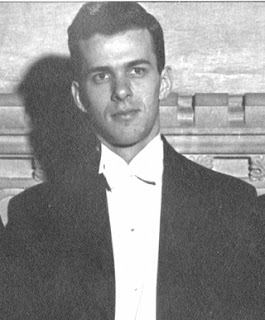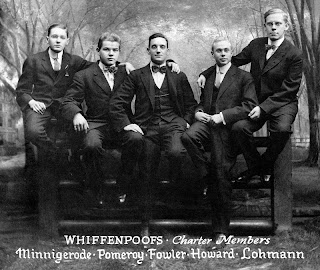I started a project a year and a half ago, to fill out the voices in my 1973 Whiffenpoof group. Our 40th reunion was approaching, and a number of us have lived far afield and have not returned to sing at reunions. Together, we sifted through names of guys we knew 40 years ago who had sung at Yale in the Glee Club, the singing groups or rock bands. We developed a list of possibles and voted. It was a long and serious process.
I also wanted to add an honorary member to our group. Irv Walradt, '41, had been overlooked by the Whiffenpoofs of 1940. Irv was a musical phenom, had perfect pitch, and had a real feel for the hip music of his day. When he got snubbed by the Whiffenpoofs, he made a decision to start his own group, one that he wanted to "last forever", called the Society of Orpheus and Bacchus. Luckily, the other guys agreed.
The Founding of The Society of Orpheus and Bacchus
Chaim Bloom, '04, had visited Mr. Walradt in Arizona, and interviewed him about his Yale experience and how the group got started. Over the years, there's been a great deal of confusion about how the SOB's got started, by whom and when. As the years have rolled on, the SOB's have been moving the goalposts backwards by a year or two. When I was with the group, the story was the group had been founded in 1939. Today, the group says its founding year was 1938. The truth is, the group was founded in 1940 by Mr. Walradt when he didn't "Whiff".
Irv Walradt '41
So, when was it, 1938, 1939 or 1940?
Actually, nobody has been trying to pull the wool over anyone's eyes or create a longer history to "one up" the other groups. The SOB's have always made the claim they are the oldest undergraduate singing group in the country. And that would still be true regardless of the year being 1940. At Yale, there is another group that claims the same thing, and there has been something of a feud going on about it for years. That group is the Spizzwinks, who convened in 1914 for one year and folded. Years later, Bill Gard, '49, "quietly" re-founded the group in the spring of 1947. So the Spizzwinks of today are like the Olympics: they have the same name but no lineage linking them back to the group of 1914. There just isn't any evidence of the group's existence from 1915 until 1947. The group itself has no records of members, musical directors or songs they sang during those years. It's a total blank.
I decided that since Irv Walradt is still alive, we should induct him into the Whiffenpoofs to honor him for his contribution to Yale singing, which is indeed immense. In addition to having a musical arrangement in the Whiffenpoof Blue Book, he founded the oldest undergraduate singing group in the country. Now let me make plain exactly how momentous this founding was, because it is really no small thing.
A Brief History of Yale A Cappella Singing
The Whiffenpoofs, founded in 1909, are considered the beginning of collegiate a cappella. They began with 5 senior members of the Varsity Glee Club. The group quickly grew to 8 and stayed around that size for many years. Each year, the seniors chose their successors, also from among the Glee Club. The Glee Club and the Whiffenpoofs were the entire singing community at Yale. The "sandlot team" for the Whiffenpoofs was the Glee Club. In 1914, the Spizzwinks appeared to give them some competition. They were 12, all seniors with the exception of one graduate student. They did not choose any successors, and there is no record of them for the next 33 years.
The Whiffenpoofs of 1909
On the other hand, the Whiffenpoofs had the drive to continue and established traditions and positions to sustain their group from year to year. The 1909 Whiffenpoofs all had nicknames hinting at the structure they devised right from the start: "founder goat", "trainer", "manager" and etc. The Spizzwinks of 1914 didn't have any such nicknames. They were not planning a future.
So fast forward now to the late 1930's. Around 1938 and 1939, there were several quartets that popped up among the Glee Club who sang on tours, maybe giving the Whiffenpoofs a little competition. These were all-senior quartets. In 1938, there was one called "The Orpheus and Bacchus Quartet" and in 1939, another called "The Orpheus and Bacchus Association". These guys sang a bit, let something of a mark, graduated and the next year another group popped up. Like the Spizzwinks of 1914, they were all seniors and did not pick successors. Why did the quartet of 1938 and 1939 have such similar names? Well, it turns out their names were bestowed on them by the Glee Club director, Marshall Bartholomew. Apparently, he thought the notion of Orpheus and Bacchus was a pretty cool thing.
It's not too likely these pickup quartets were terribly prominent. Maybe they sang on the long train rides or did a song here and there in the concert breaks. This is not very clear, but Irv Walradt who was on those Glee Club tours didn't recall ever hearing the Orpheus and Bacchus name until he presented his group to Marshall Bartholomew in the fall of 1940.
Make It Last Forever
Irv picked prime singers from the Glee Club to start his group. He was careful to pick a guy who would succeed him as musical director. He chose all his men very carefully, some who would not be graduating and some who would take leadership positions, so that his group would "last forever", as he described it. When he presented his group to Marshall Bartholomew, he had a band of guys who knew what they were starting. Barty loved it, and blessed them with a name, "The Sons of Orpheus and Bacchus". Irv remembered thinking at the time what a remarkable name this was and he thought it was so cool that Barty had accepted them and blessed them in this way.
This is how the Society of Orpheus and Bacchus was actually founded. The guys from 1938 and 1939 graduated, got jobs, enlisted in the military and fought in World War II, and later when they cam back for reunions saw there was a singing group with pretty much the same name as their little quartet. They connected the dots and decided they must have been the founders. They are part of the tradition, part of our story, but they are not founders in any true sense. Without Irv Walradt, there would not have been a group bearing that name that has lasted until today.
After World War II, men returned to their lives and many men who'd left Yale to go fight all returned at once. The Whiffenpoofs swelled in size from an octet to 15 in 1947. And they've remained around that size ever since. The extra manpower allowed them to explore more complex music. Also in 1947, a number of other groups sprung into existence, including the Spizzwinks and The Elm Street Eight. These began with the traditional size of 8-9 guys, but quickly grew. The Society of Orpheus and Bacchus also had a lot of guys return from the War, and they swelled in size like the Whiffenpoofs. The new groups all formed around the model that Irv Walradt had put in place in 1940. They had men from the undergraduate classes with roles and responsibilities to ensure they last from year to year. In truth, Irv had created the model for the undergraduate singing community that sprung up at Yale and became the training ground for future Whiffenpoofs. Within a very short time, this model was followed by college after college in the Northeast, and eventually across the entire country as the explosion of a cappella music took the country by storm.
The Center of the Storm
At the epicenter of that revolution is Irv Walradt. He came up with an idea that took hold and fostered an explosion of college a cappella because he wasn't selected for the Whiffenpoofs of 1941. And in June of 2013, we named him Irving "Up Against the" Walradt and welcomed him into the Whiffenpoofs forever. May we always remember what he did and how much joy he brought to so many generations of Yalies.


No comments:
Post a Comment